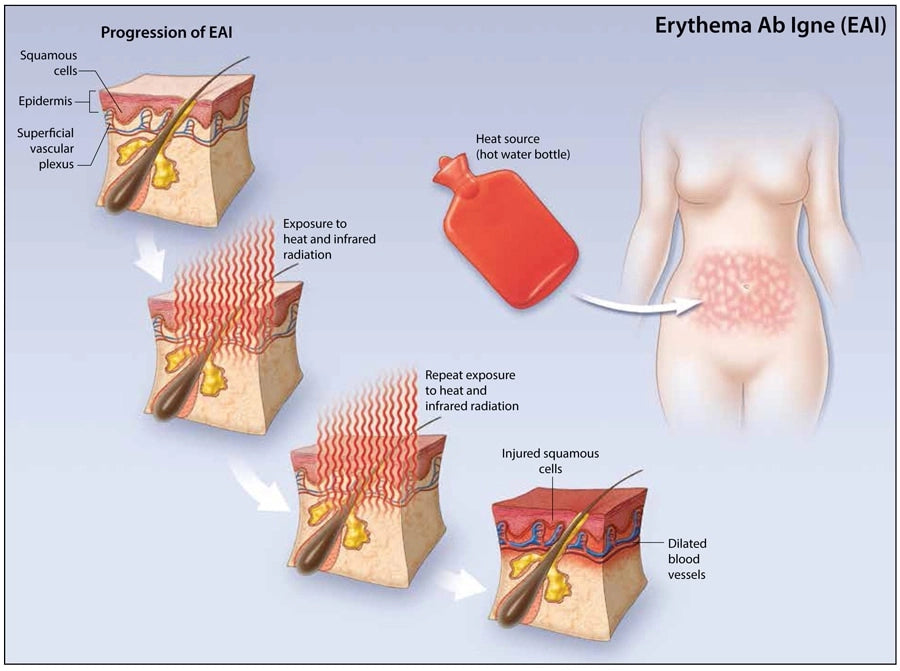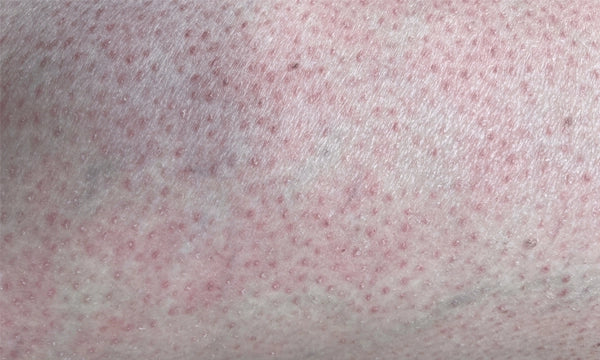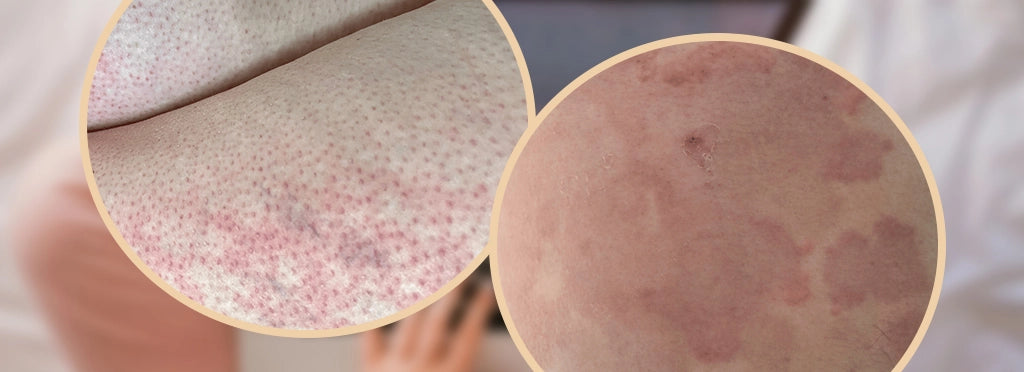Toasted Skin Syndrome: The Ultimate Guide to Causes, Treatment and Recovery
Think about the situation where you wake up in the morning and observe some strange, symmetric rashes on your skin. It looks terrifying, and you question, "What in the world is this?!" Here comes the intriguing world of Toasted Skin Syndrome, a state whose name is as mystifying as the state itself.
This article will enlighten you about everything you need to know revolving around the treatment and recovery of this extraordinary skin condition. In case it is the scorching feeling of your best friend heating pad or an odd symbol that went out of the blues, we got you covered.
Stick to us as we will answer these questions as well as many others telling you how to keep your skin in good health and shiny.
What is Toasted Skin Syndrome?
Toasted skin syndrome certainly sounds like a tasty beer, but it is a real skin condition that consumes many people's minds. An accurately named “erythema ab igne”1, this condition causes its sufferers' lattice-like patches of reddish-brown skin discoloration. The main villain here? Unprotected exposure to long-duration of high temperatures causes dilation in the skin's superficial blood vessels. Consider momentarily having your laptop resting on your lap for hours, or constantly shifting toward the heated pad's warmth.
The beginnings of this condition go back even to the times when people used to stay next to the fires or stoves and also this left similar carved patterns on the face. In the age of modernism, it's again having a revival, with small appliances and luxuries being often fingered as the cause-all.
Toasted skin syndrome doesn’t care about your skin tone either; it can perfectly affect anyone who enjoys sunbathing next to a hot spot for too long. Lack of timely diagnosis increases the risk of damage that is further irreversible or even life-threatening later on.

Progression of Toasted Skin Syndrome
Source: https://www.nkskin.com/
What Causes Toasted Skin Syndrome?
Toasted skin syndrome, or erythema ab igne, isn't just a bizarre medical term—it's a clear signal from your body that it's time to reassess your heat exposure habits. Various heat sources can inadvertently become skin hazards, leading to those distinctive, mottled skin patterns. Here’s a rundown of the usual suspects:
-
Sun Exposure: While it bathes us in light and warmth, excessive sunbathing without protection can contribute to more than just sunburns.
-
Laptops: Those marathon binge-watching or work sessions with a laptop perched on your legs? They might be cooking up more than just your next project.
-
Heating Pads: Heating pads are often used for relief from aches and pains, but when overused, they can leave a lasting impression on your skin.
-
Space Heaters: Cozying up too close for too long can turn these winter favorites into skin foes.
-
Hot Water Bottles: A classic remedy for cold nights or cramps, yet another example of heat's double-edged sword.
Each of these can be a comfort and a convenience, but moderation and protective measures are key to preventing toasted skin syndrome. Keeping a healthy distance and using these sources of warmth wisely can keep your skin safe and sound.

Is Toasted Skin Syndrome Dangerous?
When you discover those characteristic marks on your skin, the first reaction might be to panic. The truth, however, is that while toasted skin syndrome can be scary, in its early stages, it’s unlikely to prove dangerous. The point is to be familiar with the risks and understand when to turn to a doctor for advice.

In practice, toasted skin syndrome acts as a visual warning that our skin has been suffering the consequences of a heat bath for far too long. At first, it may be just slightly uncomfortable, or a matter of appearance. However, if it is left unmonitored, things can get out of hand. The ongoing increase in temperature can cause more permanent tissue changes – the affected areas of the skin become thicker and darker.
In the most regrettable cases, long-term exposure has been associated with an increased risk of developing skin cancer in the affected areas. It’s a harrowing reminder that all of our cuddling moments with a laptop or a heating pad may have unwanted effects. On the other hand, the more promising side is the fact that all these risks can be easily treated with knowledge and awareness.
If you can spot the early symptoms and compare them with your daily routine, you can control this phenomenon and avoid letting it develop into something dangerous. If you notice that your skin has become more dyed or has developed a strange texture that doesn’t diminish within a few days, you may want to consult a dermatologist.
How Long Does Toasted Skin Syndrome Last?
How long does it last is the question mark hanging over toasted skin syndrome. The happy answer is that, for many, the condition is certainly reversible, particularly if you catch it early. The period it takes for the skin to return to normal, however, relies on many key things. The intensity and amount of prolonged exposure of heat are the first factors to consider.
With adequate time, the skin may return to normal in just a few months if you have had short encounters with heating, and the heating source is taken away or the routine is altered entirely. Because the skin is such an amazing organ, this indicates that it too will heal gradually and that the discoloration and patterns indicating toasted skin syndrome will fade in time with preventative measures.
On the other hand, “if you have spent years snuggling up with heating sources, your healing journey is likely to take longer and be tougher,” says Dr. Nicol Alcaino. Patterns and discoloration on the skin may become more resistant in these situations, and may even become irreversible.
This is a severe and fatal communication that the skin records both good and bad habits. So what do you do? Your skin is speaking to you. Reduce the repeated heat exposure if you see initial indications and ensure you stay apart from it. If you have lasting or significant changes, Dr. Alcaino advises seeing a dermatologist to advise you on a personal health journey. Because each skin has its own account, carefully take it one action at a time.
How to Treat Toasted Skin Syndrome?
When it comes to treating toasted skin syndrome, there is one simple yet powerful solution: eliminate the source of heat. The damage your overheated skin does is the first step towards healing; not only that, but it also prevents further damage. However, healing does not end there. Let’s get a little closer to what you can do to calm your skin down and stimulate recovery.
-
Cooling Off and Giving Space: To begin with, it is best to take your distance from the heat. Do not sit on your laptop, heating pad, or any other warming device; your skin requires cooling off. Avoid heat with a delicate compress on the burned areas; this will reduce irritation and soothe redness.
-
Moisturize and Protect: Use moisturizers for hydration. Lotion can help restore your skin’s protective barrier and promote healing. Using an SPF 50 sunscreen on the affected areas is also essential because the damaged skin is more prone to sunburn and more discoloration.
-
Meeting with a Dermatologist: If you have persistent symptoms or worry about the condition’s positioning, it is important to contact a professional. A dermatologist may suggest treatments such as topical retinoids or laser therapy to help the appearance and discomfort.
-
Healing takes time: Everyone needs time to recover. That means some people will recover in a few months, whereas others may need a few more months. Be patient and keep shielding your skin; just relax on the correct healing path.
At Home Remedies
You don’t always need to see a doctor when it comes to taking care of toasted skin syndrome. There are safe and efficient ways to address the symptoms and aid the healing process right from the comfort of your home. Here’s how to be your skin’s best ally on its healing journey:
-
Break from the heat: The critical first step is to pinpoint and remove the heat source causing you trouble. Whether you need to switch up your seating arrangements, take regular breaks at work to prevent long exposure, or find an alternative way to keep warm, it’s all about keeping your skin away from the direct source of heat.
-
Gentle skincare routine: Invest in a skincare routine that nurtures and doesn’t add to your skin’s stress. Make sure to use gentle, fragrance-free cleansers and moisturizers to keep your skin hydrated. Steer clear of products that contain harsh chemicals and exfoliant ingredients that may only worsen the condition of your skin.
-
Perfect diet, and hydration: Your skin is a good indicator of your overall health, so drinking plenty of water and consuming wholesome foods that are rich in vitamins and minerals will go a long way for your skin. Antioxidant-rich foods are particularly beneficial.
-
Cool down: Apply cool compresses on your affected skin to alleviate discomfort immediately. Make sure the compress is not cold and avoid applying excessive pressure. Sometimes hot water bottles also work in coping with such conditions.
-
Loose and comfortable clothing: Wear loose and breathe-through materials to prevent further discomfort. Prevent heat and moisture from being trapped in your skin. Disregard tight clothing items, especially directly on top of affected areas.
Toasted Skin Syndrome from Heating Pads
Heating pads prove to be a typical perp when it comes to toasted skin syndrome, a reminder of why too much of a good thing can deteriorate quickly. While heating pads are intended to relieve body pains, excessive use of the same can lead to toasted skin syndrome romantically and unintentionally. Therefore, both parties must understand how heating pads cause toasted skin syndrome.
-
Recognize the Signs: The first thing to do is to stay on the alert. If you regularly use heating pads and feel as if your body is always hot, inspect your skin regularly to look for any patches or marks. Seeing the signs early on is crucial since it makes the management process less complicated.
-
Moderation: You can significantly reduce the hazards by limiting the use of heating pads in your body. The pads may be used for a short period since the effect does not instantly appear and perhaps diffused using a piece of cloth between the pad and your body.
-
Alternatives to Heat: Luckily, there are a plethora of other ways to ensure your body doesn’t hurt. You may want to explore the aforementioned themes. If they would help, you may engage in mild exercise or apply lotions available over the counter.
-
When to Seek Help: Persistent redness and discoloration of the skin whenever you use heating, it may be wise to consult with a professional. They can gauge the degree of heating syndrome on you and recommend probable applications.
Such choices may be from using other lotions to treatment with a physician. Use your understanding of the harm that heating pads may do to your skin to engage in it harmlessly. When using heating pads, space heaters, or any other personal heating devices like wood-burning stoves, remember that you can only utilize the comfort without succumbing to the pain.
💡 Homlyns Tips:
To avoid toasted skin syndrome, opt for our weighted heating pad with an auto timer and adjustable heat levels. The automatic shut-off feature ensures safe use, preventing prolonged exposure to heat. Its 10 heat settings allow for customized comfort, while the weighted design ensures consistent, gentle warmth without overuse.
How to Get Rid of Heating Pad Burns?
If you’ve found yourself with a burn from a heating pad, don't worry—there are steps you can take to help your skin heal and potentially minimize the appearance of toasted skin syndrome. It’s all about treating your skin with care and giving it what it needs to recover.
Immediate Actions
-
Cool the Area: As soon as you notice a burn, gently cool the area with lukewarm water. Avoid ice or extremely cold water, as these can cause further irritation.
-
Keep it Clean: Clean the area with mild soap and water. This step is crucial to prevent infection, which can complicate the healing process.
Support Healing
-
Moisturize: After cleaning, apply a gentle, unscented moisturizer to keep the skin hydrated. This helps maintain the skin's natural barrier and supports the healing process.
-
Protect From Sun: The affected area will be more sensitive to sunlight, so broad-spectrum sunscreen will be applied to protect it from further damage.
By taking immediate and proper care of heating pad burns, you can aid your skin’s recovery process and avoid long-term issues. Remember, gentle care and protection are your best allies to heal and prevent toasted skin syndrome.
Does Toasted Skin Syndrome Go Away?
One of the most pressing questions for anyone dealing with toasted skin syndrome is whether it will leave a lasting mark. The comforting news is that, in many cases, the condition does indeed fade away, especially with the right care and adjustments to repeated exposure habits.
Time and Healing
For mild cases, where the skin has only recently shown signs of erythema ab igne, removing the heat source and following a careful skincare routine can lead to significant improvement within a few months. Your skin has an incredible capacity to heal, but it requires patience and gentle treatment.
Persistent Cases
In situations where the chronic exposure has been prolonged and the condition has advanced, the complete disappearance of the markings might take longer, or in some cases, the changes could be permanent. However, even then, there are treatments and skincare practices that can help minimize appearance and prevent further damage.
Can Toasted Skin Syndrome Cause Cancer?
While the direct link between toasted skinned syndrome and squamous cell skin cancer arouses the most concern, erythema ab igne is not associated with cancer. There is one significant caveat. Unaddressed exposure to the heat source will eventually develop into chronic toasted-skinned syndrome, and this area is at increased risk of developing skin cancer.
Recognizing this risk is crucial as it highlights the importance of early intervention. Responding promptly to toasted skin syndrome and addressing the exposure problem can dramatically reduce the risk of long-term skin damage and/or more life-threatening conditions. Regular check-ups can also prove invaluable for individuals who have experienced the syndrome or who are at risk.
Dermatologists can help monitor changes in one’s skin and address them before they become major problems, as well as provide educated advice on skin health. In conclusion, toasted skin syndrome can and usually does resolve without causing permanent life damage. Avoiding long-term complications comes from understanding the syndrome, taking precautions to prevent skin damage, and seeking professional help as needed.
Pictures of Toasted Skin Syndrome
Understanding toasted skin syndrome goes beyond words; seeing it can truly underscore the importance of taking precautions. Below, we present images that highlight the distinct lattice-like patterns characteristic of the condition.
These visuals serve as a stark reminder of why maintaining a safe distance from prolonged heat sources is crucial for your skin's health. Remember, awareness is the first step towards prevention and ensuring your skin remains vibrant and healthy.

Conclusion: Find Your Warmth the Safe Way with Homlyns
In conclusion, there is nothing to worry about with toasted skin syndrome, but all that is required is that you learn how to manage and prevent it. At the moment, you have all the information you need to take care of your skin cells.
Here’s a quick recap of what we covered:
- Recognize and reduce prolonged heat exposure
- Keep your skin moisturized and protected from the sun
- Explore alternative methods for chronic pain relief
- Consult a dermatologist for persistent or severe cases
At Homlyns, we're all about bringing you coziness without compromise. Our range of high-quality, heated home and bedding products is designed to provide the ultimate comfort, ensuring you can unwind and get that restorative sleep without worrying about your skin's health. Let Homlyns be your partner in comfort, offering the warmth you need with the safety you deserve.
References:
- Haleem, Z., Philip, J., & Muhammad, S. (2021). Erythema Ab Igne: A Rare Presentation of Toasted Skin Syndrome With the Use of a Space Heater. Cureus, 13(2), e13401. https://doi.org/10.7759/cureus.13401

















Leave a comment